FLOORING DESIGN
Selecting the appropriate flooring design is essential not only for achieving visual harmony but also for maximizing the functionality of a space. Whether renovating your home or designing a new one, investing time and consideration into selecting the right flooring design is crucial for creating a cohesive and inviting environment.
Material Selection
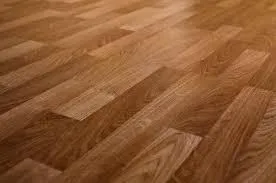
A. Hardwood Flooring
Hardwood flooring stands as a timeless epitome of elegance, capable of imparting warmth and sophistication to any space it graces. Its enduring appeal lies in its ability to evoke a sense of luxury and refinement, making it a favored choice among homeowners and interior designers.
The versatility of hardwood flooring is another aspect that sets it apart. With an extensive array of wood species, finishes, and patterns, homeowners can create unique flooring designs that reflect their style and preferences. Whether you prefer the rich tones of oak, the rustic charm of pine, or the exotic allure of Brazilian cherry, there's a hardwood option to suit every aesthetic.
Beyond its aesthetic appeal, hardwood flooring boasts exceptional durability when properly maintained. Unlike other flooring materials that may show signs of wear and tear over time, hardwood flooring has the potential to last for generations, making it a wise investment for homeowners seeking long-term value and beauty in their homes.
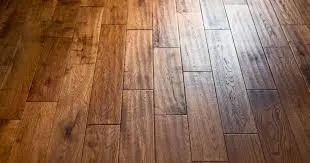
B. Tile Flooring
Tile flooring offers a world of design possibilities with endless shapes, colors, and patterns. From classic subway tiles to contemporary mosaic designs, a tile style suits every taste and aesthetic preference.
In addition to its aesthetic appeal, tile flooring is highly practical, boasting durability and water-resistant properties that make it ideal for high-traffic areas and moisture-prone spaces such as kitchens, bathrooms, and entryways.
Its resilience to moisture also makes it a suitable option for outdoor applications, allowing for seamless transitions between indoor and outdoor areas.
Furthermore, tile flooring offers unmatched versatility, with options for various design styles and applications. Whether you're aiming for a sleek, modern look or a more traditional, timeless aesthetic, tile flooring provides the perfect foundation for bringing your design vision to life.
Pattern and Layout
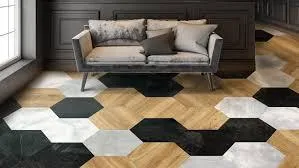
A. Geometric Patterns
Geometric patterns have emerged as a hallmark of modern sophistication in flooring design, offering a contemporary twist to traditional interiors. Designs such as hexagons, chevrons, or Moroccan-inspired motifs add a dynamic visual element that instantly elevates the aesthetic appeal of any space.
Beyond their aesthetic allure, geometric patterns are crucial in adding depth and dimension to a room. By incorporating geometric elements into flooring design, homeowners can create focal points that draw the eye and enhance the overall visual interest of the space.
One of the key advantages of geometric patterns is their flexibility. Whether you're aiming for a minimalist, Scandinavian-inspired look or a more eclectic, bohemian vibe, geometric patterns can be adapted to suit a wide range of design styles and preferences.
From subtle accents to bold statement pieces, the versatility of geometric patterns knows no bounds.

B. Organic Layouts
In contrast to the structured geometry of geometric patterns, organic layouts embrace the natural flow of design, drawing inspiration from the shapes and patterns found in nature.
By arranging flooring materials in irregular patterns or shapes, homeowners can create a sense of harmony and balance that promotes a connection to the outdoors.
Organic layouts also play a pivotal role in biophilic design, a concept that seeks to incorporate elements of nature into the built environment. By combining organic layouts into interior spaces, homeowners can foster a sense of well-being and tranquility, ultimately enhancing the overall livability of their homes.
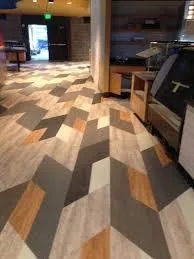
Mixing Materials
Mixing different flooring materials can have a profound visual impact on interior spaces, adding contrast, texture, and dimension to the overall design scheme. Whether it's combining hardwood with tile or carpet, the juxtaposition of different materials creates a dynamic visual interplay that enhances the aesthetic appeal of a room.
One of the key benefits of mixing materials is the opportunity to introduce contrast and texture into the design. Homeowners can create visual interest and depth that captivates the eye by pairing materials with varying colors, patterns, and textures.
For example, combining hardwood's rich, natural warmth with the sleek, contemporary tile look can create a striking contrast that adds visual intrigue to the space.
In addition to enhancing visual appeal, mixing materials can help define different zones within an open-concept space.
By strategically placing different flooring materials in designated areas, homeowners can create visual delineation between the living room, dining area, and kitchen. This not only adds clarity to the layout of the space but also enhances functionality and flow.
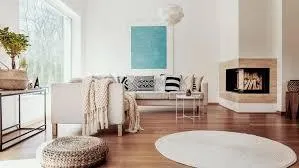
Sustainability and Eco-Friendly Options
Sustainability is a key consideration in flooring design in today's environmentally conscious world. Homeowners can minimize their environmental footprint by opting for sustainable flooring materials and eco-friendly practices while creating beautiful and functional spaces.
Renewable Materials
Choosing sustainable flooring materials such as bamboo, cork, or reclaimed wood is essential for reducing environmental impact. Unlike traditional hardwoods, which often require deforestation and extensive processing, renewable materials are harvested sustainably, ensuring minimal ecosystem disruption.
For example, Bamboo is known for its rapid growth and replenishment, making it a highly sustainable option for flooring. Similarly, cork flooring is made from the bark of cork oak trees, which can be harvested without harming the tree itself.
Reclaimed wood, sourced from old buildings or structures, reduces the demand for new timber and adds character and history to a space.
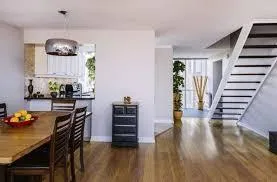
Low VOC Options
In addition to considering the environmental impact of materials, it's important to prioritize indoor air quality when selecting flooring options. Many traditional flooring materials emit volatile organic compounds (VOCs), which can negatively impact indoor air quality and contribute to health problems such as respiratory issues and headaches.
Choosing flooring materials with low VOC emissions is crucial for maintaining a healthy indoor environment. Options such as low-VOC paints, adhesives, and finishes help minimize off-gassing and ensure that indoor air quality remains pristine.
Eco-Friendly Practices
Beyond selecting sustainable materials, homeowners can reduce their environmental footprint by embracing eco-friendly installation techniques and maintenance practices. This includes opting for adhesives and sealants free from harmful chemicals and choosing installation methods that minimize waste and energy consumption.
Additionally, implementing eco-friendly maintenance practices such as regular cleaning with non-toxic products and using area rugs or furniture pads to protect flooring can prolong the lifespan of flooring materials and reduce the need for replacements.
DISCOVER
THE CRAFTSMAN DIFFERENCE
With award-winning third-generation craftsman, Matt Garcia.
FAQS
What is the difference between hardwood and engineered hardwood flooring?
Hardwood flooring is made from solid planks of wood. Engineered hardwood flooring is made with a plywood core and a thin veneer of hardwood on top. Hardwood flooring is more expensive than engineered hardwood flooring, but it is also more durable and can last for many years. Engineered hardwood flooring is less expensive than hardwood flooring, but it is not as durable and may need to be replaced sooner.
What is the best way to clean and maintain my carpet?
The best way to clean and maintain your carpet is to vacuum it regularly and have it professionally cleaned once a year. When vacuuming your carpet, be sure to use a vacuum cleaner with a beater bar to remove dirt and dust from the fibers. When having your carpet professionally cleaned, be sure to choose a reputable company that uses a cleaning method that is appropriate for your type of carpet.
What is the best way to protect my floors from water damage?
The best way to protect your floors from water damage is to avoid spills and leaks. If you do have a spill or leak, be sure to clean it up immediately. You can also protect your floors from water damage by placing mats and rugs in high-traffic areas and by sealing your floors regularly.
TRANSFORM YOUR HOME WITH A CLICK
Why wait for elegance? A free, personalized estimate from Craftsman Hardwood Flooring is just a click away. Join a growing community who have elevated their homes with our exquisite, award-winning flooring designs. Matt Garcia and his team are committed to bringing your vision to life with precision and passion.
Get Your No-Obligation, Free Estimate: Simply fill out our quick form, and we'll provide you with a personalized estimate that aligns with your unique needs and preferences.
See the Difference for Yourself: Browse our gallery of stunning installations and read real testimonials from our satisfied clients.
Let's Create Something Beautiful Together: Start your journey towards a home that truly reflects your style and sophistication. Request your estimate now and step into the world of Craftsman Hardwood Flooring!
Here at Craftsman Hardwood Flooring, we understand that your home is a reflection of your personal style and taste. That's why we offer top-quality hardwood flooring solutions designed to elevate the beauty and functionality of any space.
With our easy-to-use form, you can request a no-obligation, free estimate for your project. This personalized estimate will provide you with an accurate understanding of the costs involved in creating the perfect hardwood floors for your home.
But don't just take our word for it - see the difference for yourself by browsing through our gallery of stunning installations. These real-life examples showcase the exceptional craftsmanship and attention to detail that goes into every project we undertake.
Still not convinced? Take a look at what our satisfied clients have to say
LOCATION
Craftsman Hardwood Floors
958 Arroyo St.
San Angelo, TX 76903
Main Office: (888) 841-8453
QUICK LINKS
COPYRIGHT © 2023
ALL RIGHTS RESERVED. // PRIVACY POLICY // TERMS AND CONDITIONS

